Flash Memory Tutorial
Flash memory is non volatile memory designed to store data on the chip without requiring any power to retain the information. Flash memory technology is primarily seen in data storage mediums such as flash memory cards or USB flash drives, but was originally used to store firmware or BIOS information on motherboards, routers, and other computer hardware. The key advantages of flash memory above other storage methods are low power consumption, no moving parts, and nearly instantaneous access times. Flash memory cards used in conjunction with flash memory card readers are also superior replacements of legacy removable storage devices such as floppy drives, zip drives, and under some circumstances even the ubiquitous optical drive. Though the current cost of solid state drives (SDD) which utilize flash memory technology deter potential lower and mid range markets, SDD drives are steadily decreasing in dollar-per-bit ratio and are expected to become popular as permanent storage devices.
Types of Flash Memory Cards
Below is a list of the most frequently seen flash memory cards on the market today.
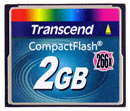 |
Compact Flash (CF) CF is the most popular flash memory card due to it's low cost-per-bit ratio and higher storage capacities, and are commonly used in digital cameras, camcorders, and digital audio players. Compact Flash are categorized by a physical difference in dimensions, Type I and Type II with the larger sized Type II used . CF cards are currently the only flash memory cards supporting True IDE interface, which make it valuable as a boot device identified by the system as a real hard drive. Many industrial CF cards have been manufactured to withstand more extreme temperatures and have a greater amount of read/write cycles. With the latest CF spec 4.0, CF cards can support UDMA 5/ 6.
|
||||||
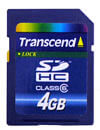 |
Secure Digital (SD) SD cards are another popular type of flash memory card used by many portable devices including cameras, camcorders, PDA's, cell phones, digital audio players, and video game consoles. The new Secure Digital High Capacity (SDHC) format supports capacities exceeding 2GB, but was not developed to be backwards compatible with many older SD card readers.
|
||||||
 |
Memory Stick (MS) MS is another type of flash memory card seen on cameras, digital audio players, and cell phones, though it's usage is mostly limited to Sony's own line of products. Other formats in the MS family include MS Pro, MS Duo, MS Pro Duo, MS Micro, and MS Pro-HG.
|
||||||
 |
Smart Media (SM) SM cards were marketed as a replacement for floppy disks, and initially held a large portion of the market as flash memory in digital cameras. However, the capacity limit of 128MB and it's larger physical size caused the SM to soon be replaced by SD cards. Though many multi-card readers still support this older flash memory format, SM cards are no longer being manufactured.
|
An introduction of Addonics technology designed for flash memory
Addonics has developed high quality flash memory readers and card adapters for various purposes.
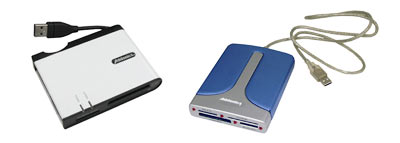 |
External Card Readers These card readers are a simple method to effortlessly connect a flash memory card onto the computer. Our card readers support various different types of flash media to be connected onto the externally computer via USB or eSATA. External card readers are generally lightweight and optimized for portability, great for consumers with more than one computer. When connected through USB, our card readers are plug and play, capable of BUS power, and hot swappable under nearly every operating system. When connected through eSATA, users can depend on the 1.5Gbps maximum throughput to access data from the flash memory card at speeds greatly surpassing USB. When connected onto a hot swappable eSATA controller, these devices can even be added and removed without rebooting the system. |
 |
Internal Card Readers These card readers are designed to be installed permanently into a computer case's drive bay. By mounting internal card readers into the easily accessible front panels, cards can be inserted and removed in the same way as a DVD, floppy disk, or zip drive, to be detected by the system as removable storage. Internal card readers can be connected directly onto the motherboard or internal add-in card using USB 2.0/1.1, IDE, or even SATA interface. When connected through USB, our card readers are plug and play, capable of BUS power, and hot swappable under nearly every operating system. When connected through SATA, users can depend on the 1.5Gbps maximum throughput to access data from the flash memory card at speeds greatly surpassing USB. When connected onto a hot swappable SATA controller, these devices can even be added and removed without rebooting the system. |
 |
Removable Card Slot Adapters This family of flash memory adapters brings the speed and convenience of flash memory storage to notebook users through the PCMCIA, Cardbus, and ExpressCard 34/54 slots. |
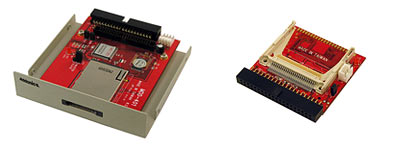 |
Bootable Flash Memory Adapters |
Permanent Storage and Booting Applications
Compact Flash have become an attractive option to use as a replacement for hard drives for a variety of reasons. As the speed, reliability, and storage capacity of flash memory constantly improves, flash memory has been increasingly more popular in permanent storage applications, replacing traditional rotating disk hard drives on laptops, industrial PCs, and Small Form Factor (SFF) systems, as well as any other computers used in environments where prevalent dust and vibration, harsh temperatures, or noise requirements make traditional hard drives not suitable.
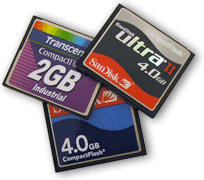 |
Key advantages of Compact Flash media above traditional hard disk drives
|
List of Operating Systems We've Tested to Boot with our CF Adapters
- Windows XP sp2
- Windows XP Media Center 2005
- Windows XP Embedded, Feature Pack 2007
- Windows 98
- Fedora Core 5
- Fedora Core 7
- FreeDOS 1.0
- Damn Small Linux (DSL)
- OpenSUSE 10
- Sabayon Linux v3.3
- IPCop 1.4
- Slax Standard Edition 1.5.1.8.1
- M0n0wall v1.231

